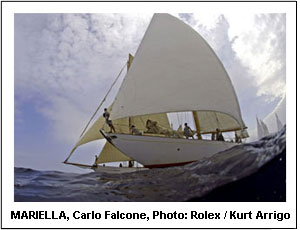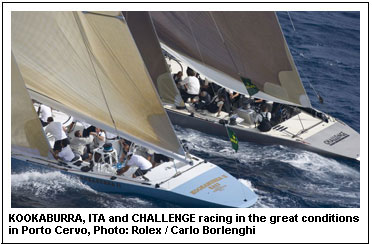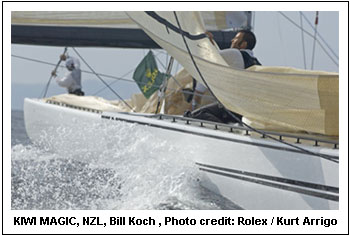|
Mistral Keeps 12 Metres In Port
September
11, 2007
 Today
should have seen the start of the Rolex Veteran
Boat Rally 2007. Strong winds stopped that
and, instead, journalists and spectators attending
the event took advantage of the postponement to
brush up on the history of one part of the fleet
that has gathered so far. Today
should have seen the start of the Rolex Veteran
Boat Rally 2007. Strong winds stopped that
and, instead, journalists and spectators attending
the event took advantage of the postponement to
brush up on the history of one part of the fleet
that has gathered so far.
In 1906 an International
Conference on Yacht Measurement was held in London
to try and devise an international rule of measurement
for racing yachts that was acceptable to all European
countries. The conference was attended by the
various European yachting authorities and a set
of measurement rules was agreed upon eventually
in 1907. On 1st January 1908, a version of the
International Measurement Rule was implemented
and read as follows:
(L
+ B + 1/3G + 3d + 1/3SQR{S} - F) /
2 = 12 Metres
For those not versed in scientific
formula and yacht design terminology, and wondering
what relevance this piece of history and equation
might have to the Rolex Veteran Boat Rally that
should have started today (had the Mistral not
arrived bringing 60 knot gusts to the Straits
of Bonifacio cancelling any prospect of racing
for the day), the critical bit is 12 Metres. This
seemingly innocuous answer did, in fact, mark
the spawning of an era in the yachting that was
to be at the forefront of the racing world for
some 80 years - albeit with some evolutionary
changes to the formula that consequently led to
developments in design style and construction
techniques. Some of which set the world on fire
and some of which were swiftly consigned to the
dustbin of oddball ideas. The connection with
this event is that 2007 marks the Centenary of
the Metre Classes and as part of the celebrations
a 12 Metre Division has been included at the Rolex
Veteran Boat Rally 2007.
In the absence of any racing
today and, in an effort to shed some light on
the calculation to make it a bit more meaningful,
the letters are explained thus:
L = waterline length
D = difference between girth and chain
B = beam
S = sail area
G = chain girth
F = freeboard
Further explanation of the terms
could take months - a quick search on the Internet
may help!
In order for a yacht to fit
within the rule, the results of the formula could
not exceed 12 metres. In practice, the Rule was
much more complex and open to interpretation.
The Rule Book contained around 20 pages of text.
Included were parameters designed to control maximum
and minimum mast height, draft, beam and headsail
height thereby attempting to limit the diversity
amongst the boats. Of course, yacht designers
being yacht designers, they would take advantage
of every loophole and omission to create the fastest
design possible while still complying with the
Rule. Methods included increasing or decreasing
the length of the hull, the sail area and freeboard;
all the while balancing these with the shape of
hull, keel and rudder to create the least amount
of resistance, the greatest amounts of stability
and lift. So successful was the Class in its early
years that it was selected for three Olympic Games
- 1908, 1912 and 1920.
The really old 12 Metres remain
as beautiful today as when they were first launched.
Fine, classic looking craft adhering to the principle
of overall look being as important as speed. There
are three at the Rolex Veteran Boat Rally - Zinita
(1927), built under the 2nd Version of the 12
Metre Rule; along with Vanity V (1936) and Trivia
(1937), built under the 3rd and final version
of the principal rule, which still stands today
and reads:
(L + 2d - F +SQR{S})
/ 2.37 = 12 Metres
In 1958, the history of the 12
Metre Class became intertwined with the then pinnacle
competition in the sport of big-boat racing -
the America 's Cup. These 60- to 70-foot sloops
were deemed more manageable than the 135-foot
J boats that had previously been involved. The
12 Metre formula-based design meant that irrespective
of the smaller size there was still scope for
yachts to vary in sail area, length, and other
speed producing aspects. Their involvement in
the Cup ended in 1987.
At the Rolex Veterans there are
six 12 Metres from the Cup period: Challenge 12
(1983), Courageous (1974) and Freedom (1980) race
as Modern; whilst Kiwi Magic (1986),
Kookaburra
II (1986) and Wright on White (1983) race as Grand
Prix.
 The
histories of these yachts are inextricably linked
to the Cup and the stories about their triumphs
and despairs are limitless. And for those still
racing these yachts, maintaining the legacy and
legend is as important as the racing itself. The
histories of these yachts are inextricably linked
to the Cup and the stories about their triumphs
and despairs are limitless. And for those still
racing these yachts, maintaining the legacy and
legend is as important as the racing itself.
Kookaburra II was designed by
John Swarbrick and Iain Murray and built in 1986
as part of the Taskforce 87 syndicate that competed
in the Defender trials for 1987 America 's Cup
held in Perth , Australia . Her sistership, Kookaburra
III, won those trials and went on to lose to Dennis
Connor and Stars&Stripes in the final. The
yacht is now in Italian ownership and has been
chartered for this event by Patrizio Bertelli,
head of the Luna Rossa and Prada campaigns at
the last three Cups. Antonio Marrai, the owners'
representative, described how the new owners came
to bring the yacht to Italy , "we found her
in Sydney Harbour together with her twin sister,
Kookaburra III, being used for corporate races.
We thought she would have good characteristics
for sailing in the Mediterranean so we bought
her in 2000. We invested five months in returning
her to being a 'boat'. She is now back to her
best shape as she was during the Cup." Kookaburra
II has an aluminium hull, which brings with it
maintenance and care issues and she is not left
for too long in the water. In refitting her, Marrai
also explained why they chose an old boat and
how, as much as possible, they tried to avoid
interfering with her original specification, "during
the work we reused the same materials and we decided
not to equip her with modern winches or other
such equipment. we did replace the mast and adopted
new sails, but she basically remains pretty much
the same she was during the Cup. She requires
care, competence and passion to look after her.
With no passion there is no point to choose an
old boat instead of new technological one!"
Also here from the '87 Cup is
Kiwi Magic. She was designed by three scions of
the New Zealand yachting community - Ron Holland,
Laurie Davidson and Bruce Farr. Back then she
was campaigned by Chris Dickson and was defeated
in the Challenger series final by Stars&Stripes.
She has a special place in the pantheon of 12
Metre design since she was the first fibreglass
yacht to sail in the Cup. Peter Grubb manages
the boat for one Bill Koch - head of the America3
syndicate that won back the Cup for America in
San Diego in 1992. Grubb describes how her new
owner has adopted a slightly different approach
to Bertelli, "Mr Koch purchased the boat
four years ago. He has kept her really up-to-date
and tried to modernize the boat as much as he
could within the rule. The boat has gone through
a few changes and mostly involving the mast and
the keel, but the hull is basically the same."
Since bringing her to the Med this year, there
have been more changes, "right now we have
configured the boat a little bit differently from
how she was originally built. She was built to
sail in quite heavy wind, but we have tried to
mode the boat a little bit down for the lighter
wind here in the Mediterranean ."
 Both
boats have a clutch of sailing 'rock stars' -
past and present - in their rosters. Aside from
Koch, in the Kiwi Magic crew are helmsman Alexis
(Lexi) Gahagan ( USA ) a Cup sailor from both
the 12s and IACC era; Ian Baker (NZL), Stu Argo
(USA) and Eric Doyle (USA) are other Cup alumni,
whilst Bob Billingham is an Olympic Silver medalist
from 1988 in the Soling. Amongst Kookaburra II's
claims to fame are helmsman Philippe Presti (FRA),
part of the Luna Rossa Cup programme, and Steve
Erickson USA ), an Olympic Gold medalist in the
Star. Both
boats have a clutch of sailing 'rock stars' -
past and present - in their rosters. Aside from
Koch, in the Kiwi Magic crew are helmsman Alexis
(Lexi) Gahagan ( USA ) a Cup sailor from both
the 12s and IACC era; Ian Baker (NZL), Stu Argo
(USA) and Eric Doyle (USA) are other Cup alumni,
whilst Bob Billingham is an Olympic Silver medalist
from 1988 in the Soling. Amongst Kookaburra II's
claims to fame are helmsman Philippe Presti (FRA),
part of the Luna Rossa Cup programme, and Steve
Erickson USA ), an Olympic Gold medalist in the
Star.
The weather outlook for tomorrow
suggests that racing will take place. The wind
will rotate to the east overnight. In the morning
the fleet may expect 13-18 knots from the northeast,
decreasing in the afternoon to 9-14 knots as it
moves further east.
Yesterday (10th September) did
see some racing as elements of the Maxi Yacht
Rolex Cup and Rolex Veteran Boat Rally fleets
joined with other invited boats to celebrate the
fortieth anniversary of the foundation of the
Yacht Club Costa Smeralda. It's not often one
gets the chance to see Neville Crichton's ultra-modern
98-foot Alfa Romeo (NZL on a start line alongside
Tuiga (MON) 30-metre Fife sloop launched 1909.
But they, along with some 40 other yachts of various
sizes and age raced over the same 22-mile course,
that saw Luigi Arturo Carpaneda and Bottadritta
5, a Ron Holland designed sloop, emerge as overall
victor from the eclectic mix. The evening prizegiving
and party on the Piazza Azzurra, supported by
Rolex, formed a fitting end to a day of celebration
and an appropriate forerunner to the racing and
social programme that lay ahead at the Rolex Veteran
Boat Rally.
The Rolex Veteran Boat Rally
2007 is organized by the Yacht Club Costa Smeralda
and will run from September 11th to September
15th. 12 Metre racing tales place from 11th-13th
inclusive and Veteran boat racing from the 13th-15th
inclusive.
For more information about the
Rolex Veteran Boat Rally 2007 including entry
lists and results please visit www.yccs.it
TOP
|

 Today
should have seen the start of the Rolex Veteran
Boat Rally 2007. Strong winds stopped that
and, instead, journalists and spectators attending
the event took advantage of the postponement to
brush up on the history of one part of the fleet
that has gathered so far.
Today
should have seen the start of the Rolex Veteran
Boat Rally 2007. Strong winds stopped that
and, instead, journalists and spectators attending
the event took advantage of the postponement to
brush up on the history of one part of the fleet
that has gathered so far. The
histories of these yachts are inextricably linked
to the Cup and the stories about their triumphs
and despairs are limitless. And for those still
racing these yachts, maintaining the legacy and
legend is as important as the racing itself.
The
histories of these yachts are inextricably linked
to the Cup and the stories about their triumphs
and despairs are limitless. And for those still
racing these yachts, maintaining the legacy and
legend is as important as the racing itself. Both
boats have a clutch of sailing 'rock stars' -
past and present - in their rosters. Aside from
Koch, in the Kiwi Magic crew are helmsman Alexis
(Lexi) Gahagan ( USA ) a Cup sailor from both
the 12s and IACC era; Ian Baker (NZL), Stu Argo
(USA) and Eric Doyle (USA) are other Cup alumni,
whilst Bob Billingham is an Olympic Silver medalist
from 1988 in the Soling. Amongst Kookaburra II's
claims to fame are helmsman Philippe Presti (FRA),
part of the Luna Rossa Cup programme, and Steve
Erickson USA ), an Olympic Gold medalist in the
Star.
Both
boats have a clutch of sailing 'rock stars' -
past and present - in their rosters. Aside from
Koch, in the Kiwi Magic crew are helmsman Alexis
(Lexi) Gahagan ( USA ) a Cup sailor from both
the 12s and IACC era; Ian Baker (NZL), Stu Argo
(USA) and Eric Doyle (USA) are other Cup alumni,
whilst Bob Billingham is an Olympic Silver medalist
from 1988 in the Soling. Amongst Kookaburra II's
claims to fame are helmsman Philippe Presti (FRA),
part of the Luna Rossa Cup programme, and Steve
Erickson USA ), an Olympic Gold medalist in the
Star.